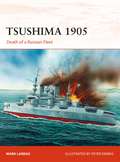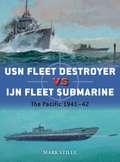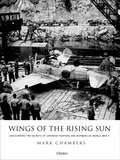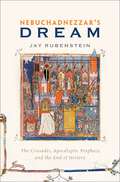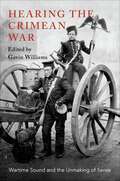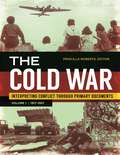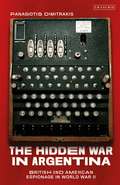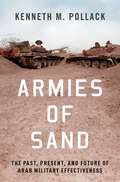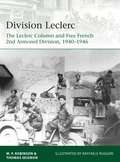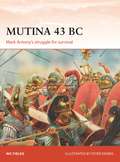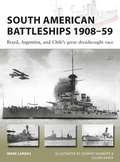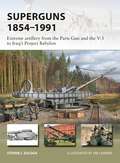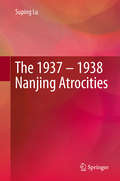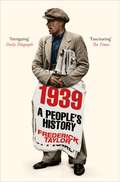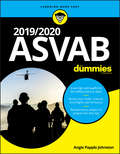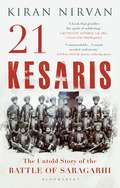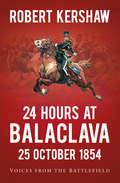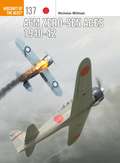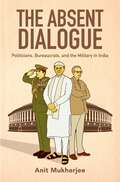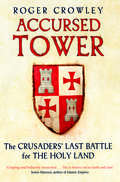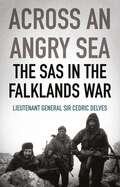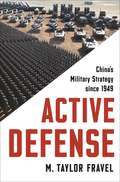- Table View
- List View
Tsushima 1905: Death of a Russian Fleet (Campaign)
by Peter Dennis Mark Lardas Nikolai Bogdanovic Bounford.com Bounford.com Paul KimeJapan was closed to the world until 1854 and its technology then was literally medieval. Great Britain, France and Russia divided the globe in the nineteenth century, but Japan was catching up. Its army and navy were retrained by Western powers and equipped with the latest weapons and ships. Japan wanted to further emulate its European mentors and establish a protectorate over Korea, yet Japanese efforts were blocked by Imperial Russia who had their own designs on the peninsula.The Russo-Japanese War started with a surprise Japanese naval attack against an anchored enemy fleet still believing itself at peace. It ended with the Battle of Tsushima, the most decisive surface naval battle of the 20th century. This gripping study describes this pivotal battle, and shows how the Japanese victory over Russia led to the development of the dreadnought battleship, and gave rise to an almost mythical belief in Japanese naval invincibility.
USN Fleet Destroyer vs IJN Fleet Submarine: The Pacific 1941–42 (Duel)
by Paul Wright Mark StilleLeading up to the Pacific War, Japanese naval strategists believed that a decisive fleet engagement would be fought against the United States Navy. Outnumbered by the USN, the Imperial Japanese Navy planned to use its large, ocean-going submarines to chip away at its opponent before the grand battle. In order to accomplish this, the IJN's submarine force was tasked to perform extended reconnaissance of the USN's battle fleet, even in port, and then shadow and attack it.For their part, the USN was fully aware of the potential threat posed by Japanese submarines, and destroyer crews were trained and equipped with modern anti-submarine weapons and tactics to screen the battle fleet. Challenging the assumption that Japanese submarines were ineffective during the Pacific War, this fully illustrated study examines their encounters with the US Navy, and the successes and failures of American destroyers in protecting their capital ships.
Wings of the Rising Sun: Uncovering the Secrets of Japanese Fighters and Bombers of World War II
by Mark ChambersIn the Pacific War's early years, Japanese air power was dominant. The only way for the Allies to defeat their enemy was to know it. This made the task of maintaining productive intelligence gathering efforts on Japan imperative. Establishing Technical Air Intelligence Units in the Pacific Theatre and the Technical Air Intelligence Center in Washington DC, the Allies were able to begin to reveal the secrets of Japanese air power through extensive flight testing and evaluation of captured enemy aircraft and equipment. These provided an illuminating perspective on Japanese aircraft and aerial weapon design philosophy and manufacturing practice.Fully illustrated throughout with a wealth of previously unpublished photographs, Mark Chambers explores Allied efforts to evaluate the strengths and weaknesses of Japanese air power during the war years, and how this intelligence helped them achieve victory in the Pacific.
Nebuchadnezzar's Dream: The Crusades, Apocalyptic Prophecy, and the End of History
by Jay RubensteinIn 1099, the soldiers of the First Crusade took Jerusalem. As the news of this victory spread throughout Medieval Europe, it felt nothing less than miraculous and dream-like, to such an extent that many believed history itself had been fundamentally altered by the event and that the Rapture was at hand. As a result of military conquest, Christians could see themselves as agents of rather than mere actors in their own salvation. The capture of Jerusalem changed everything. A loosely defined geographic backwater, comprised of petty kingdoms and shifting alliances, Medieval Europe began now to imagine itself as the center of the world. The West had overtaken the East not just on the world's stage but in God's plans. To justify this, its writers and thinkers turned to ancient prophecies, and specifically to one of the most enigmatic passages in the Bible the dream King Nebuchadnezzar has in the Book of Daniel, of a statue with a golden head and feet of clay. Conventional interpretation of the dream transformed the state into a series of kingdoms, each less glorious than the last, leading inexorably to the end of all earthly realms-- in short, to the Apocalypse. The First Crusade signified to Christians that the dream of Nebuchadnezzar would be fulfilled on their terms. Such heady reconceptions continued until the disaster of the Second Crusade and with it, the collapse of any dreams of unification or salvation-any notion that conquering the Holy Land and defeating the Infidel could absolve sin. In Nebuchadnezzar's Dream, Jay Rubenstein boldly maps out the steps by which these social, political, economic, and intellectual shifts occurred throughout the 12th century, drawing on those who guided and explained them. The Crusades raised the possibility of imagining the Apocalypse as more than prophecy but actual event. Rubenstein examines how those who confronted the conflict between prophecy and reality transformed the meaning and memory of the Crusades as well as their place in history.
Hearing the Crimean War: Wartime Sound and the Unmaking of Sense
What does sound, whether preserved or lost, tell us about nineteenth-century wartime? Hearing the Crimean War: Wartime Sound and the Unmaking of Sense pursues this question through the many territories affected by the Crimean War, including Britain, France, Turkey, Russia, Italy, Poland, Latvia, Dagestan, Chechnya, and Crimea. Examining the experience of listeners and the politics of archiving sound, it reveals the close interplay between nineteenth-century geographies of empire and the media through which wartime sounds became audible--or failed to do so. The volume explores the dynamics of sound both in violent encounters on the battlefield and in the experience of listeners far-removed from theaters of war, each essay interrogating the Crimean War's sonic archive in order to address a broad set of issues in musicology, ethnomusicology, literary studies, the history of the senses and sound studies.
The Cold War [2 volumes] [2 volumes]: 2 volumes [2 volumes]
This detailed two-volume set tells the story of the Cold War, the dominant international event of the second half of the 20th century, through a diverse selection of primary source documents.One of the most extensive to date, this set of primary source documents studies the Cold War comprehensively from its beginning, with the emergence of the world's first communist government in Russia in late 1917, to its end, in 1991. All of the key events, including the Berlin Blockade, the Korean War, the Cuban Missile Crisis, the Vietnam War, and the nuclear arms race, are discussed in detail. The primary sources provide insight into the thinking of all participants, drawing on Western, Soviet, Asian, and Latin American perspectives.In The Cold War: Interpreting Conflict through Primary Documents primary documents are organized chronologically, allowing readers to appreciate the ramifications of the Cold War within a clear time frame. Extensive interpretive commentary provides in-depth background and context for each document. This work is an indispensable reference for all readers seeking to become deeply knowledgeable about the Cold War.
The Hidden War in Argentina: British and American Espionage in World War II
by Panagiotis DimitrakisThough officially neutral until March 1945, Buenos Aires played a key role during World War II as a base for the South American intelligence operations of the major powers. The Hidden War in Argentina reveals the stories of the spymasters, British, Americans and Germans who plotted against each other throughout the Second World War in Argentina. In Buenos Aires, Johannes Siegfried Becker – codename 'Sargo' – was the man responsible for organizing most of the Nazi intelligence gathering in Latin America and the leader of 'Operation Bolivar', which sought to bring South America into the war on the side of the Axis powers. After the attack on Pearl Harbor the US state department pressured every South American country to join it in declaring war on Germany, and J Edgar Hoover authorized huge investments in South American intelligence operations. Argentina continued to refuse to join the conflict, triggering a US embargo that squeezed the country's economy to breaking point. Buenos Aires continued to be a hub for espionage even as the war in Europe was ending – hundreds of high-ranking Nazi exiles sought refuge there. This book is based on newly declassified files and details of the operations of MI6, the Abwehr, the Sicherheitsdienst (SD) and the FBI, as well as the OSS and the SOE. Most significantly, The Hidden War in Argentina reveals for the first time the coups of Britain's MI6 in South America.
Armies of Sand: The Past, Present, and Future of Arab Military Effectiveness
by Kenneth M. PollackSince the Second World War, Arab armed forces have consistently punched below their weight. They have lost many wars that by all rights they should have won, and in their best performances only ever achieved quite modest accomplishments. Over time, soldiers, scholars, and military experts have offered various explanations for this pattern. Reliance on Soviet military methods, the poor civil-military relations of the Arab world, the underdevelopment of the Arab states, and patterns of behavior derived from the wider Arab culture, have all been suggested as the ultimate source of Arab military difficulties. In Armies of Sand, Kenneth M. Pollack assesses these differing explanations and isolates the most important causes. Over the course of the book, he examines the combat performance of fifteen Arab armies and air forces in virtually every Middle Eastern war, from the Jordanians and Syrians in 1948 to Hizballah in 2006 and the Iraqis and ISIS in 2014-2017. The book ultimately concludes that reliance on Soviet doctrine was more of a help than a hindrance to the Arabs. In contrast, politicization and underdevelopment were both important factors limiting Arab military effectiveness, but patterns of behavior derived from the dominant Arab culture was the most important factor of all. Pollack closes with a discussion of the rapid changes occurring across the Arab world, and suggests that because both Arab society and warfare are changing, the problems that have bedeviled Arab armed forces in the past could dissipate or even vanish in the future, with potentially dramatic consequences for the Middle East military balance. Sweeping in its coverage, this will be the go-to reference for anyone interested in the history of warfare in the Middle East since 1945.
Division Leclerc: The Leclerc Column and Free French 2nd Armored Division, 1940–1946 (Elite)
by Raffaele Ruggeri Merlin Robinson Thomas Seignon'General Leclerc' was the nom de guerre adopted by the Gaullist officer Philippe de Hautcloque, to protect his family in occupied France. He became France's foremost fighting commander, and his armored division (the '2e DB') its most famous formation. Starting as a small scratch force of mostly African troops organised and led by Leclerc in French Equatorial Africa, it achieved early success raiding Italian and German positions in co-operation with Britain's Long Range Desert Group. Following the Allied victory in North Africa it was expanded and reorganised as a US Army-style armoured division, with American tanks and other armoured vehicles. Shipped to the UK, in spring 1944, it was assigned to Patton's US Third Army, landing in time for the Normandy breakout and being given the honour of liberating Paris in August 1944. Combining a thorough analysis of their combat and organisation with detailed colour plates of their uniforms and equipment, this is the fascinating story of Free France's most effective fighting force.
Mutina 43 BC: Mark Antony's struggle for survival (Campaign)
by Peter Dennis Nic Fields Bounford.com Bounford.com Paul KimeIn the aftermath of the murder of Gaius Julius Caesar, his self-declared successor Mark Antony struggled to hold together his legacy. Following an abortive coup attempt by Caesar's adopted son Octavian, two of Antony's legions declared for him, leading to a renewed outbreak of civil war. Antony moved into northern Italy and invaded the city of Mutina, which was held by Decimus Brutus. There they were quickly sandwiched between the city walls on one side and the newly arrived Senate-backed forces of Octavian on the other.These two heirs of Caesar then fought to claim their former mentor's legacy. Fully illustrated with specially commissioned artwork and maps, this is the full story of the battles which would see Octavian move from being a young, inexperienced aristocrat to the dominating figure of Augustus.
South American Battleships 1908–59: Brazil, Argentina, and Chile's great dreadnought race (New Vanguard)
by Mark LardasIn 1908 the most incredible naval arms race in history began. Flush with cash from rubber and coffee, Brazil decided to order three of the latest, greatest category of warship available – the dreadnought battleship. One Brazilian dreadnought by itself could defeat the combined gunnery of every other warship of all the other South American nations. Brazil's decision triggered its neighbour Argentina to order its own brace of dreadnoughts, which in turn forced Chile (which had fought boundary disputes with Argentina) to order some.In the process, the South American dreadnought mania drove the three participants nearly into insolvency, led to the bankruptcy of a major shipyard, and triggered a chain of events which led Turkey to declare war on Great Britain. It also produced several groundbreaking dreadnought designs and one of the world's first aircraft carriers.
Superguns 1854–1991: Extreme artillery from the Paris Gun and the V-3 to Iraq's Project Babylon (New Vanguard)
by Steven J. ZalogaOver the last 150 years, gun designers have sought to transform warfare with artillery of superlative range and power, from William Armstrong's 19th-century “monster guns” to the latest research into hypersonic electro-magnetic railguns.Taking a case study approach, Superguns explains the technology and role of the finest monster weapons of each era. It looks at the 1918 “Wilhelm Gun,” designed to shell Paris from behind the German trenches; the World War II “V-3” gun built to bombard London across the Channel; the Cold War atomic cannons of the US and Soviet Union; and the story of Dr Gerald Bull's HARP program and the Iraqi “Supergun” he designed for Saddam Hussein. Illustrated throughout, this is an authoritative history of the greatest and most ambitious artillery pieces of all time.
The 1937 – 1938 Nanjing Atrocities
by Suping LuThis book presents a comprehensive overview of the Nanjing Massacre, together with an in-depth analysis of various aspects of the event and related issues. Drawing on original source materials collected from various national archives, national libraries, church historical society archives, and university libraries in China, Japan, Germany, United Kingdom and the United States, it represents the first English-language academic attempt to analyze the Nanjing Massacre in such detail and scope.The book examines massacres and other killings, in addition to other war crimes, such as rape, looting, and burning. These atrocities are then explored further via a historical analysis of Chinese survivors’ testimony, Japanese soldiers’ diaries, Westerners’ eyewitness accounts, the news coverage from American and British correspondents, and American, British and German diplomatic dispatches. Further, the book explores issues such as the role and function of the International Committee for Nanking Safety Zone, burial records of massacre victims, post-war military tribunals, controversies over the Nanjing Massacre, and the 100-Man Killing Contest.This book is intended for all researchers, scholars, graduate and undergraduate students, and members of the general public who are interested in Second World War issues, Sino-Japanese conflicts, Sino-Japan relations, war crimes, atrocity and holocaust studies, military tribunals for war crimes, Japanese atrocities in China, and the Nanjing Massacre.
1939: A People's History
by Frederick Taylor‘In 1939: A People's History, Frederick Taylor has done us a great service in making the personal stories of what it was actually like to live through the most crucial year of the twentieth century vivid, compelling and salutary.’ - Roland Philipps, author of A Spy Named Orphan: The Enigma of Donald MacleanIn the autumn of 1938, Europe believed in the promise of peace. Still reeling from the ravages of the Great War, its people were desperate to rebuild their lives in a newly safe and stable era. But only a year later, the fateful decisions of just a few men had again led Europe to war, a war that would have a profound and lasting impact on millions of innocent people. From the bestselling historian Frederick Taylor, 1939: A People's History draws on original British and German sources, including recorded interviews, as well as contemporary diaries, memoirs and newspapers. Its narrative focuses on the day-to-day experiences of the men and women in both countries trapped in this disastrous chain of events and not, as is so often the case, the elite. Their voices, concerns and experiences lend a uniquely intimate flavour to this often surprising account, revealing a marked disconnect between government and people; few ordinary citizens in either Britain or Germany wanted war. Precisely for that reason, 1939: A People's History is also an interrogation of our capacity to go to war again. In today’s Europe, an onset of uncertainty, a looming fear of radical populism and a revelatory schism are dangerously reminiscent of the perils of the autumn of 1938. It is both a vivid and richly peopled narrative of Europe’s slide into the horrors of war, a war that nobody wanted, and, in many ways, a warning; an opportunity for us to learn from our history and a reminder that we must never take peace for granted.
2019/2020 ASVAB For Dummies
by Angie Papple JohnstonThe bestselling ASVAB study guide—now updated and improved for 2019/2020! More than 1 million students and potential recruits take the ASVAB every year, including 400,000 recruits and 900,000 high school students. Since the test was first introduced in 1968, more than 40 million people have taken the exam. 2019/2020 ASVAB For Dummies is packed with practice questions, an in-depth review of each of the nine subtests, strategy cheat sheets, proven study tips, and so much more. New for this edition, potential recruits will find expanded math coverage, with more content review and practice questions for the Math Knowledge and Arithmetic Reasoning sections of the exam. Score high and qualify for the military job you want Boost your math, science, and English performance Review all nine subject areas to prepare for test day Take three full-length ASVAB practice tests and two AFQT practice tests If you’re preparing for this all-important exam, this hands-on study guide makes it easier than ever to take your military career to new heights.
2019/2020 ASVAB For Dummies
by Angie Papple JohnstonThe bestselling ASVAB study guide—now updated and improved for 2019/2020! More than 1 million students and potential recruits take the ASVAB every year, including 400,000 recruits and 900,000 high school students. Since the test was first introduced in 1968, more than 40 million people have taken the exam. 2019/2020 ASVAB For Dummies is packed with practice questions, an in-depth review of each of the nine subtests, strategy cheat sheets, proven study tips, and so much more. New for this edition, potential recruits will find expanded math coverage, with more content review and practice questions for the Math Knowledge and Arithmetic Reasoning sections of the exam. Score high and qualify for the military job you want Boost your math, science, and English performance Review all nine subject areas to prepare for test day Take three full-length ASVAB practice tests and two AFQT practice tests If you’re preparing for this all-important exam, this hands-on study guide makes it easier than ever to take your military career to new heights.
21 Kesaris: The Untold Story of the Battle of Saragarhi
by Kiran Nirvan10,000 Afghans. 21 Sikh soldiers. One epic battle. On 12 September 1897, 21 Sikh soldiers of 36th SIKH Regiment stood undeterred as they guarded the post of Saragarhi against the onslaught of almost 10,000 Afghan tribesmen – a battle for the ages that ended in them giving their lives in a final hand-to-hand combat. The unparalleled heroics of these 21 men have, however, been long forgotten by history. What led to the Battle of Saragarhi? What was the socio-political scenario at the time? Who were these tribesmen and why did they attack an outpost with such numerical superiority? Who were the 21 soldiers and how were they able to keep the enemy at bay against all odds? Based on colonial era records and information provided by the 4 Sikh Battalion of Indian Army, the legatee unit of 36th SIKHs, 21 Kesaris attempts to answer these questions while paying homage to the brave soldiers who defended the 'kesari' flag – depicting their Khalsa heritage – with their last breaths.
24 Hours at Balaclava: Voices from the Battlefield
by Robert KershawIN 1854 Britain and France were at war to save ‘poor little Turkey’, the crumbling Ottoman Empire, from the menace of Russian expansionism. On 25 October they were nine days into what would become an eleven-month siege, with little to show for it. Suddenly, from behind them came the unmistakeable sound of cannon. The Russians had arrived. Vastly outnumbered, the British gained an unlikely upper hand with the charge of the Heavy Brigade and the efforts of the Thin Red Line. But then, within two hours of achieving near victory, the British squandered it in dramatic style with the charge of the Light Brigade. Using eyewitness accounts, letters and diaries, acclaimed military historian Robert Kershaw presents a new, intimate look at the Battle of Balaclava, from the perspective of the men who ‘saw little and knew even less’. Come down from the Heights and see the real story of one of the most ill-fated military expeditions in British history.
A6M Zero-sen Aces 1940-42 (Aircraft of the Aces #137)
by Nicholas MillmanThe Mitsubishi A6M Zero-sen was Japan's Spitfire. In continuous development and operational service from the time of the Sino-Japanese war in 1940 to the end of the Pacific War in 1945, it is held in almost mythical awe, similar to Britain's legendary fighter aircraft. At the time of its operational debut the fighter's design features offered the revolutionary combination of an all-round vision canopy, cannon armament and a jettisonable drop tank giving it phenomenal range. Together with the flying and tactical proficiency of superbly trained pilots, this made the Zero-sen a true strategic fighter, spearheading Japan's offensive in the Pacific. It was also the mount of a plethora of successful and flamboyant naval aces engaged in both sea and land campaigns. This volume, the first of two on the A6M Zero-sen, covers the use of the A6M2 variant from its debut in China to the Solomons Campaign, and also tells the story of the A6M2-N "Rufe" floatplane fighter aces.
The Absent Dialogue: Politicians, Bureaucrats, and the Military in India (Modern South Asia)
by Anit MukherjeeCivilian control over the military is widely hailed as one of the major successes of India's democracy. Because it is so rare, especially among post-colonial states, this control is rightfully celebrated. But has this come at a cost? In The Absent Dialogue, Anit Mukherjee argues that the pattern of civil-military relations in India has hampered its military effectiveness. Diving deep into understanding the organization and internal processes within the Indian military, he explains how Indian politicians and bureaucrats have long been content with the formal and ritualistic exercise of civilian control, while the military continues to operate in institutional silos. Yet, there has been little substantive engagement between the two. To support this claim, Mukherjee closely examines the variables most closely associated with military effectiveness-weapons procurement, jointness (the ability of separate military services to operate together), officer education, promotion policies, and defense planning. Further, Mukherjee shows how India's pattern of civil-military relations-best characterized as an absent dialogue-adversely affects each of these processes. While the book focuses on India, it also highlights the importance of civilian expertise and institutional design in enhancing civilian control and military effectiveness in other democracies. Informed by more than a hundred and fifty interviews and recently available archival material, The Absent Dialogue sheds new light on India's military and will reshape our understanding of both the history and contemporary dynamics of civil-military relations and recurring problems therein.
Accursed Tower: The Crusaders' Last Battle for the Holy Land
by Roger CrowleyThe city of Acre, powerfully fortified and richly provisioned, was the last crusader stronghold. When it fell in 1291, two hundred years of Christian crusading in the Holy Land came to a bloody end. With his customary narrative brilliance and immediacy, Roger Crowley chronicles the tumultuous and violent attack on Acre, the heaviest bombardment before the age of gunpowder, which left this once great Mediterranean city a crumbling ruin. The ‘Accursed Tower’ was the focal point of this siege. As the last garrison of the Crusader defences, it came to symbolise the disintegration of the old world and the rise of a new era of Islamic jihad. Crowley’s narrative is based on forensic research, drawing heavily on little known first hand sources, both Christian and Arabic. This is a fast-paced and gripping account of a pivotal moment in world history.
Across an Angry Sea: The SAS in the Falklands War
by Cedric DelvesIn early summer 1982--winter in the South Atlantic--Argentina's military junta invades the Falklands. Within days, a British Royal Navy Task Force is assembled and dispatched. This is the story of D Squadron, 22 SAS, commanded by Cedric Delves. The relentless tempo of events defies belief. Raging seas, inhospitable glaciers, hurricane-force winds, helicopter crashes, raids behind enemy lines--the Squadron prevailed against them all, but the cost was high. Eight died and more were wounded or captured. Holding fast to their humanity, D Squadron's fighters were there at the start and end of the Falklands War, the first to raise a Union Jack over Government House in Stanley. Across an Angry Sea is a chronicle of daring, skill and steadfastness among a tight-knit band of brothers; of going awry, learning fast, fighting hard, and winning through.
Active Defense: China's Military Strategy since 1949 (Princeton Studies in International History and Politics #167)
by M. Taylor FravelWhat changes in China’s modern military policy reveal about military organizations and strategySince the 1949 Communist Revolution, China has devised nine different military strategies, which the People’s Liberation Army (PLA) calls “strategic guidelines.” What accounts for these numerous changes? Active Defense offers the first systematic look at China’s military strategy from the mid-twentieth century to today. Exploring the range and intensity of threats that China has faced, M. Taylor Fravel illuminates the nation’s past and present military goals and how China sought to achieve them, and offers a rich set of cases for deepening the study of change in military organizations.Drawing from diverse Chinese-language sources, including memoirs of leading generals, military histories, and document collections that have become available only in the last two decades, Fravel shows why transformations in military strategy were pursued at certain times and not others. He focuses on the military strategies adopted in 1956, 1980, and 1993—when the PLA was attempting to wage war in a new kind of way—to show that China has pursued major change in its strategic guidelines when there has been a significant shift in the conduct of warfare in the international system and when China’s Communist Party has been united.Delving into the security threats China has faced over the last seven decades, Active Defense offers a detailed investigation into how and why states alter their defense policies.
Active Defense: China's Military Strategy since 1949 (Princeton Studies in International History and Politics #167)
by M. Taylor FravelWhat changes in China’s modern military policy reveal about military organizations and strategySince the 1949 Communist Revolution, China has devised nine different military strategies, which the People’s Liberation Army (PLA) calls “strategic guidelines.” What accounts for these numerous changes? Active Defense offers the first systematic look at China’s military strategy from the mid-twentieth century to today. Exploring the range and intensity of threats that China has faced, M. Taylor Fravel illuminates the nation’s past and present military goals and how China sought to achieve them, and offers a rich set of cases for deepening the study of change in military organizations.Drawing from diverse Chinese-language sources, including memoirs of leading generals, military histories, and document collections that have become available only in the last two decades, Fravel shows why transformations in military strategy were pursued at certain times and not others. He focuses on the military strategies adopted in 1956, 1980, and 1993—when the PLA was attempting to wage war in a new kind of way—to show that China has pursued major change in its strategic guidelines when there has been a significant shift in the conduct of warfare in the international system and when China’s Communist Party has been united.Delving into the security threats China has faced over the last seven decades, Active Defense offers a detailed investigation into how and why states alter their defense policies.
Active Defense: China's Military Strategy since 1949 (Princeton Studies in International History and Politics #167)
by M. Taylor FravelWhat changes in China’s modern military policy reveal about military organizations and strategySince the 1949 Communist Revolution, China has devised nine different military strategies, which the People’s Liberation Army (PLA) calls “strategic guidelines.” What accounts for these numerous changes? Active Defense offers the first systematic look at China’s military strategy from the mid-twentieth century to today. Exploring the range and intensity of threats that China has faced, M. Taylor Fravel illuminates the nation’s past and present military goals and how China sought to achieve them, and offers a rich set of cases for deepening the study of change in military organizations.Drawing from diverse Chinese-language sources, including memoirs of leading generals, military histories, and document collections that have become available only in the last two decades, Fravel shows why transformations in military strategy were pursued at certain times and not others. He focuses on the military strategies adopted in 1956, 1980, and 1993—when the PLA was attempting to wage war in a new kind of way—to show that China has pursued major change in its strategic guidelines when there has been a significant shift in the conduct of warfare in the international system and when China’s Communist Party has been united.Delving into the security threats China has faced over the last seven decades, Active Defense offers a detailed investigation into how and why states alter their defense policies.
